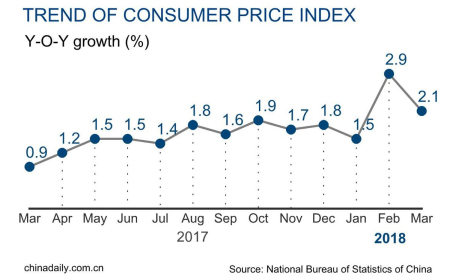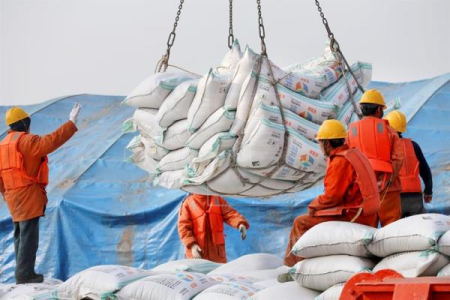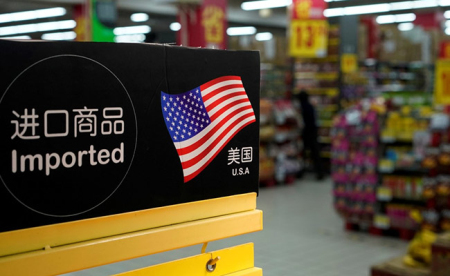Growth Slows Down In China
By Morgan Brady
 今年中国的经济增长似乎并没有去年那么快。最近的数据显示,在五个月连续下滑后,通胀降至17个月来的最低水平,这显示出居民需求下降。3月份生产者价格指数增长了3.1%,而2月份为3.7%。作为消费者价格指数的一个重要组成部分,食品价格下降了4.2%,基本抵消了2月份的4.4%的涨幅,成为导致CPI下降的罪魁祸首。服务价格指数也是CPI的一个组成部分,下跌了0.7%,但分析师预计这一指数将在未来有所回升。
今年中国的经济增长似乎并没有去年那么快。最近的数据显示,在五个月连续下滑后,通胀降至17个月来的最低水平,这显示出居民需求下降。3月份生产者价格指数增长了3.1%,而2月份为3.7%。作为消费者价格指数的一个重要组成部分,食品价格下降了4.2%,基本抵消了2月份的4.4%的涨幅,成为导致CPI下降的罪魁祸首。服务价格指数也是CPI的一个组成部分,下跌了0.7%,但分析师预计这一指数将在未来有所回升。
美国依然是影响中国经济走势的一大原因。此前美国总统特朗普宣布了许多贸易保护主义措施,通过对许多进口商品设定关税来减少美国对华贸易逆差,这在很大程度上影响了中国的出口商贸企业的发展。随着美国对医疗、技术等产品征收关税,中国3月份出口额可能会继续下降。不过有专家表示, 3月份出口下降的趋势很可能是暂时性的,其原因是季节性因素,因为与去年同期相比,3月份出口额增长了14.1%。另一因素是债务市场随着中国政府削减债务而走向疲软。房地产市场增长放缓也是影响增速的原因之一。一些经济学家预测,通胀的下行趋势将会持续下去,许多分析师已经将通胀预期下调了一年。央行行长的发言也证实了这一观点,他表示今年通胀上涨压力预计较小。
进口商品方面则未停下脚步,由于大量制造商正在为即将到来的旺季需求的消费增长做准备,很多企业增加了进口,其中包括大豆、铜、原油和铁矿石等商品。
总体而言,海关总署第一季度实现贸易顺差3261.8亿元人民币,出口增长7.4%,进口增长11.7%。通货膨胀的降低表明经济增长正在放缓,但造成这种下降的主要因素是短期因素,其影响力可能不会持续太久。
China’s growth this year does not seem to be going as smoothly as it did last year. Recent data showed that the factory gate inflation dropped to its lowest level in 17 months, following a continuous decline for five months in a row. This signals a decline in demand, especially when considering that consumer inflation also retreated sharply as sales dropped following the end of the holiday in February.
The producer price inflation (PPI) showed a very modest gain of 3.1 pct in March, as compared to 3.7 pct in February, whereas consumer price inflation showed a small gain of +2.1 pct in the same month from a print of 2.6 in February.
 Breaking Down the Consumer Price Index
Breaking Down the Consumer Price Index
Food prices, an element of the consumer price index, fell by 4.2%, erasing the gains of 4.4% achieved in February. The consumer price inflation is deviating from the government’s target of 3% inflation for the ongoing year. The fall in food prices was the main culprit behind the decline in CPI.
The service price index, also a component of CPI, dropped by 0.7%, but analysts expect this component to regain its strength as they believe the weakness is caused by seasonal factors.
 Factors behind the Easing Inflation
Factors behind the Easing Inflation
Many factors stand behind this decline. First is the high base effect from last year, according to the national bureau of statistics, which means that the comparison benchmark is particularly too high. Second is the trade tensions instigated by the US, after Donald Trump announced many protectionist measures to reduce the US’s trade deficit with China by setting tariffs on many imports to the US, albeit that the effect of mutual tariffs between the US and China have more to do with sentiment than with the actual impact which is limited. The third factor is the softening debt market as China’s government cracks down on debt. The fourth factor is the higher borrowing cost resulting from this crackdown making many investments unfeasible. And finally, the fifth factor is the real estate market which is slowing down.
Some economists predict that this downward trend in inflation will continue, and many analysts have revised their inflation expectation downward for the year. The governor of the Central Bank in China also confirmed this view as he saw less upward pressures on inflation, and expected it to be mild this year.
 Lower Exports
Lower Exports
Another sign of slower activity was the lower export record in March. This caused Shanghai’s composite index – a benchmark for Chinese equities – to decline by 0.66 down to 3159 points as it revived worries that growth is slowing down.
The fall in exports, however, did not do much to affect the impressive quarterly trade figures with America, which revealed that China’s trading surplus with the US had surged 20% in that period. Yet, this rise may have been due to manufacturers and businesses rushing to ship products to the US before the implemented tariffs are effective. China’s declining exports in March may continue to decline further with imposed tariffs by America on medical, and technology products, among others, although the timeline for implementing them is still not clear.
Even when China sold more to the US in the first quarter, it bought more from the rest of the world and it had a trade deficit with the remaining countries. Size of this deficit was $9.8 billion in the first quarter. This was the opposite of expectations of a higher surplus than in February as analysts predicted a growth of 10% in comparison with February growth record of 6.3%.
Decline in exports affected industries and tech firms alike, which can be a threat to China’s “made in China 2025” strategy that aspires to build China’s growth on high-value products rather than cheap prices. However, China’s aluminum exports increased to the highest level since June, when the United States imposed tariffs on aluminum and steel.
Analysts believe that the decline of exports in March to be most likely temporary and not a long term direction. Looking at the larger picture, exports grew by 14.1% in comparison with the same a year ago. The momentum is still to the upside, and the reason for temporary decline, according to analysts, is seasonal factors.
As manufacturers were preparing for a rise in demand with the high season, they increased their imports. This included imports of soybeans, copper, crude oil, and iron ore, among others.
Overall, the general administration of customs reported a trade surplus of 326.18 billion Yuan ($51 billion) for the first quarter as exports increased by 7.4% and imports by 11.7%.
Conclusion
Easing inflation signals that growth is faltering. But majority of factors causing this decline are short term and the effects may not last. Growth could speed back up again given its previous momentum.
A temporary slowdown in growth in March exports did not affect the good trade performance of the Chinese economy in the first quarter of the year. President trump is leading a trade war against China, but China’s economy remains robust and it is likely to emerge victorious in such a war.